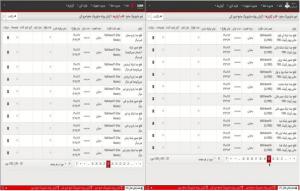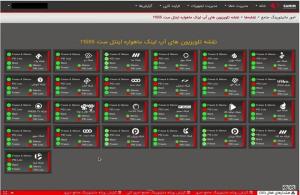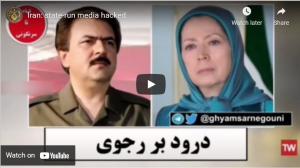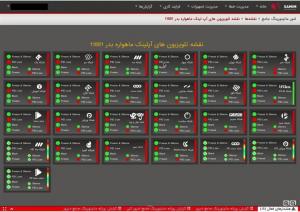Iran: Regime Broadcasting Organization’s monitoring system, 25 TV channels disrupted

The “comprehensive monitoring” system for the “Islamic Republic of Iran Broadcasting (IRIB)” clearly shows that as of Thursday afternoon, January 27, 2022, the uplink feed from 25 national television channels completely shut off.

Hundreds of national radio channels, provincial and local TV stations were critically disrupted and their audio, video, or transmission was cut off control sheets show more than 2,000 “critical” warnings on regime radio and TV stations.

This latest report follows a recent disruption of state TV and radio channels on Thursday, January 27, that resulted in the broadcasting of footage of Iranian Resistance leader Massoud Rajavi, and Mrs. Maryam Rajavi.
Hundreds of national radio stations, provincial and local city television stations were also on “critical alert” status and on the verge of shutting down.
The “comprehensive monitoring” system for the “Islamic Republic of Iran Broadcasting (IRIB)” clearly shows that as of Thursday afternoon, January 27, 2022, the uplink feed from 25 national television channels on Intelsat and 20 national television channels on Badr satellites were completely shut off.
Hundreds of national radio stations, provincial and local city television stations were also on “critical alert” status and on the verge of shutting down.
It is well known that the IRIB is one of the most heavily budgeted and highly sensitive organizations for the clerical regime, and the regime utilizes this organization alongside the IRGC, the intelligence services, and the State Security Force for suppression and censorship. The organization also serves to export fundamentalism and spread terrorism abroad alongside the Quds Force.
This latest report follows a recent disruption of state TV and radio channels on Thursday, January 27, that resulted in the broadcasting of footage of Iranian Resistance leader Massoud Rajavi, and Mrs. Maryam Rajavi, the President-elect of the Iranian opposition coalition National Council of Resistance of Iran (NCRI). That disruption has raised outrage and grave concerns among the regime’s official and state media outlets.
According to the “Comprehensive Monitoring” system, as can be seen in the chart above, the red bars on the right in each block of the chart and the small red icons, “PID Loss” indicate the complete disconnection of TV channels 1, 2, 3, 4, Tehran, News, Education, Quran, Documentary, Namayesh, Ofogh, iFilm, Press TV, Nahal via Pouya, Salamat, Nasim, Tamasha, Omid, Sepehr, HD documentary, Varzesh (Sport), Iran Kala, Varzesh (Sport) HD, Ch.3 HD, and Shoma network.
The chart below also shows that the uplink for 20 TV channels out of 25 channels on Badr satellite was also cut off and only one channel, iFilm, was not completely cut off, although that too suffered from PID Loss. Four HD channels, Channel 3, Tamasha, documentary, and sports were in an unknown state.
IRIB “Comprehensive monitoring” charts show a total of more than two thousand cases of “critical” warnings on the regime’s national, provincial and local radio and television stations in different parts of the country on Thursday afternoon, January 27, 2022. These charts, samples of which are copied below, show the uplink status on each channel.
The entire report has been made available to the Security and Counter-Terrorism Committee of the National Council of Resistance of Iran (NCRI) and is available for publishing if necessary.
Some provincial and local TV channels that according to the “comprehensive monitoring” charts were cut off, or described as “critical” include: TV channels for Hamedan, Khorasan, Kish, Kohgiluyeh and Boyer Ahmad, Fars, Kermanshah, Sistan and Baluchestan (Hamoon), Kurdistan Network, Mahabad Network, Khorasan Razavi Network, Chaharmahal and Bakhtiari Network, North Khorasan Network, Hormozgan Network, Ilam Network, Abadan Network, Khuzestan Network, Kermanshah Network, Qom Network, Mazandaran Network, East Azerbaijan Network (Tabriz ), Isfahan Network, Semnan Network, West Azerbaijan Network (Urmia), Yazd Network, Zanjan Network, Lorestan Network, Bushehr Network, Golestan Network, Gilan Network, Ardabil Network, Kerman Network, Qazvin Network, Sistan and Baluchestan Network, Al-Alam Network, South Khorasan Network, Panj Network, Omid Network, Iran Kala Network, Ofogh Network, Jam-e Jam Network, Sahar Network, Al-Kawthar Network, Hispan Network, Central Network, Isfahan TV, Kish Network, Jam-e Jam 2 Network, Sahar-kordi Network, Sahar-Azari Network, Sahar-Urdu Network, Pouya Network, Jam-e Jam 1 Network, and many others.
Some of the disconnected radio channels include: Radio Iran, Radio Tehran, Namayesh Radio, Saba Radio, Talawat Radio, Salamat Radio, Eqtesad Radio, Arabic Overseas Radio, Farhang Radio, Tartil Radio, Ziarat Radio, Hormozgan Radio, Hamedan, Alborz Radio, Abadan Radio, Fars Radio, Quran Radio, Gofto-Gu Radio, Ava Radio, Namayesh Radio, Hasti Radio, Tartil Radio, English Overseas Radio, Ziarat Radio, Sistan and Baluchestan Radio, Kish Radio, Mahabad Radio, Radio Kohgiluyeh and Boyer-Ahmad, Radio Khuzestan, Radio Fars, Radio Kermanshah, Radio Khorasan Razavi, Radio Qazvin, Radio Qom, Radio Mazandaran, Radio Chaharmahal Bakhtiari (Shahrekord), Radio Isfahan, Radio Semnan, Radio West Azerbaijan (Urmia), Radio Yazd, Radio Zanjan, Radio Lorestan, Radio Bushehr, Radio Golestan, Radio Gilan, Radio Overseas Rasht, Radio Overseas Golestan, Radio Kerman, Radio Overseas Razavi, Radio Overseas Tabriz, Radio Payam, Radio Maaref, Radio Dari, Young Radio, Sports Radio, Dari Radio, South Khorasan Radio, North Khorasan Radio, Central Radio, Radio East Azerbaijan (Tabriz), Radio Kurdistan, Radio Overseas 1, Radio Overseas 5, Radio Overseas 7, Radio Overseas 4, Radio Iran, Radio Overseas 6, Radio Nama, Radio Nama Javan, Radio Nama Iran, Radio Nama Ava, Radio Nama Payam Radio Nama Talavat, Radio Talavat FM, Radio Nama Tartil, and many others.
Thursday’s blows inflicted on the clerical regime’s radio and television system, used for oppression and censorship, were so extensive that after four days, the networks have still not been reinstated to normal operation. It is therefore understandable why according to the IRGC’s affiliated media, Javan, on January 29, they refer to the disruptions as “complicated,” “unprecedented,” “completely extraordinary and unbelievable.”
Shahin Gobadi
NCRI
+33 6 51 65 32 31
email us here


